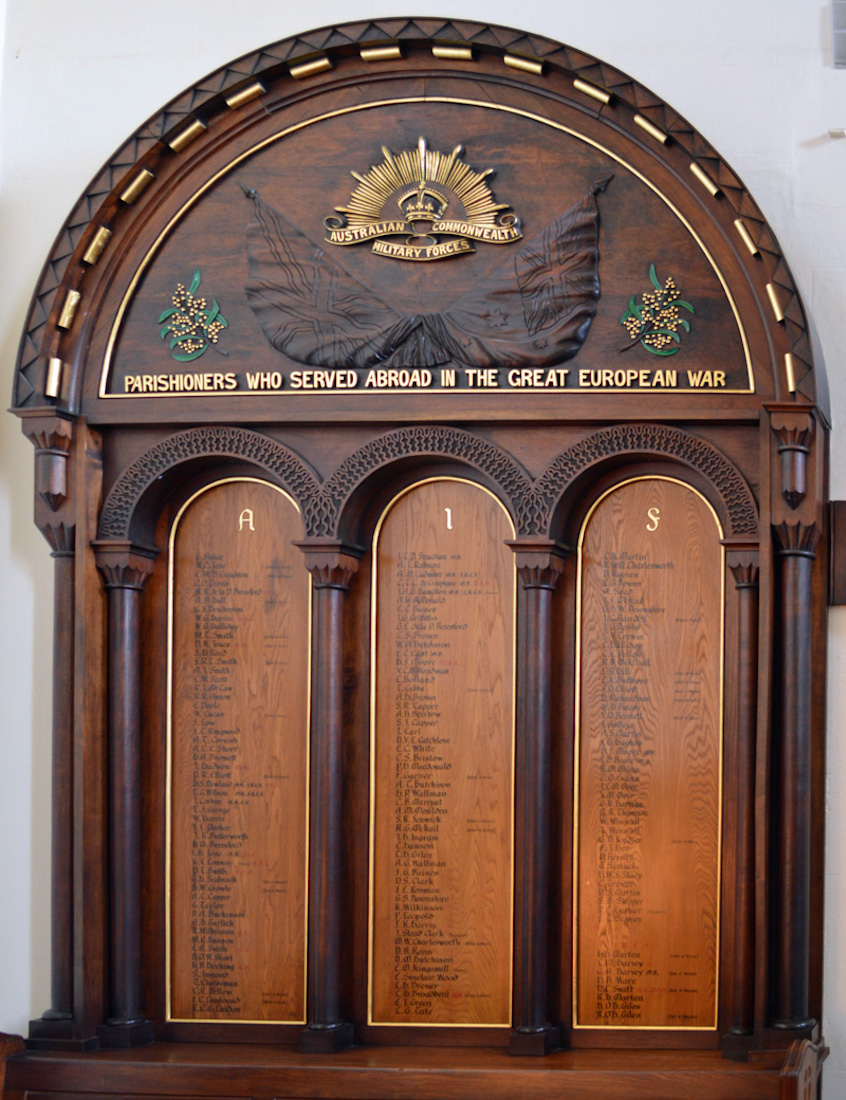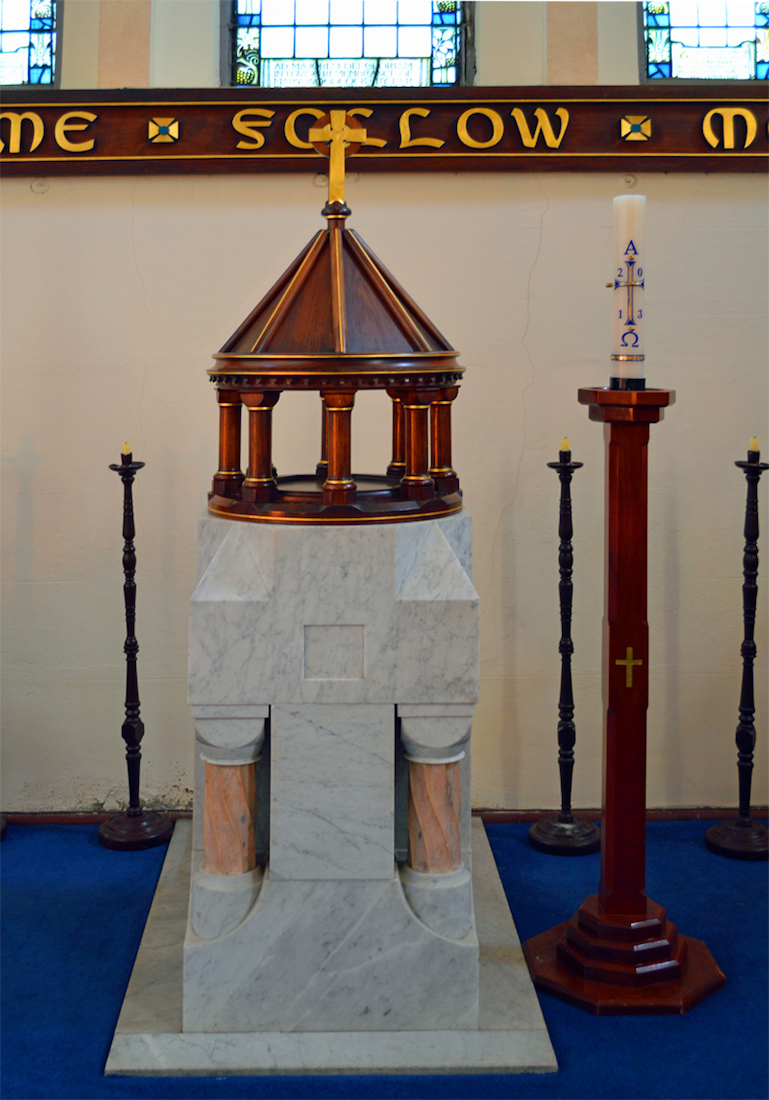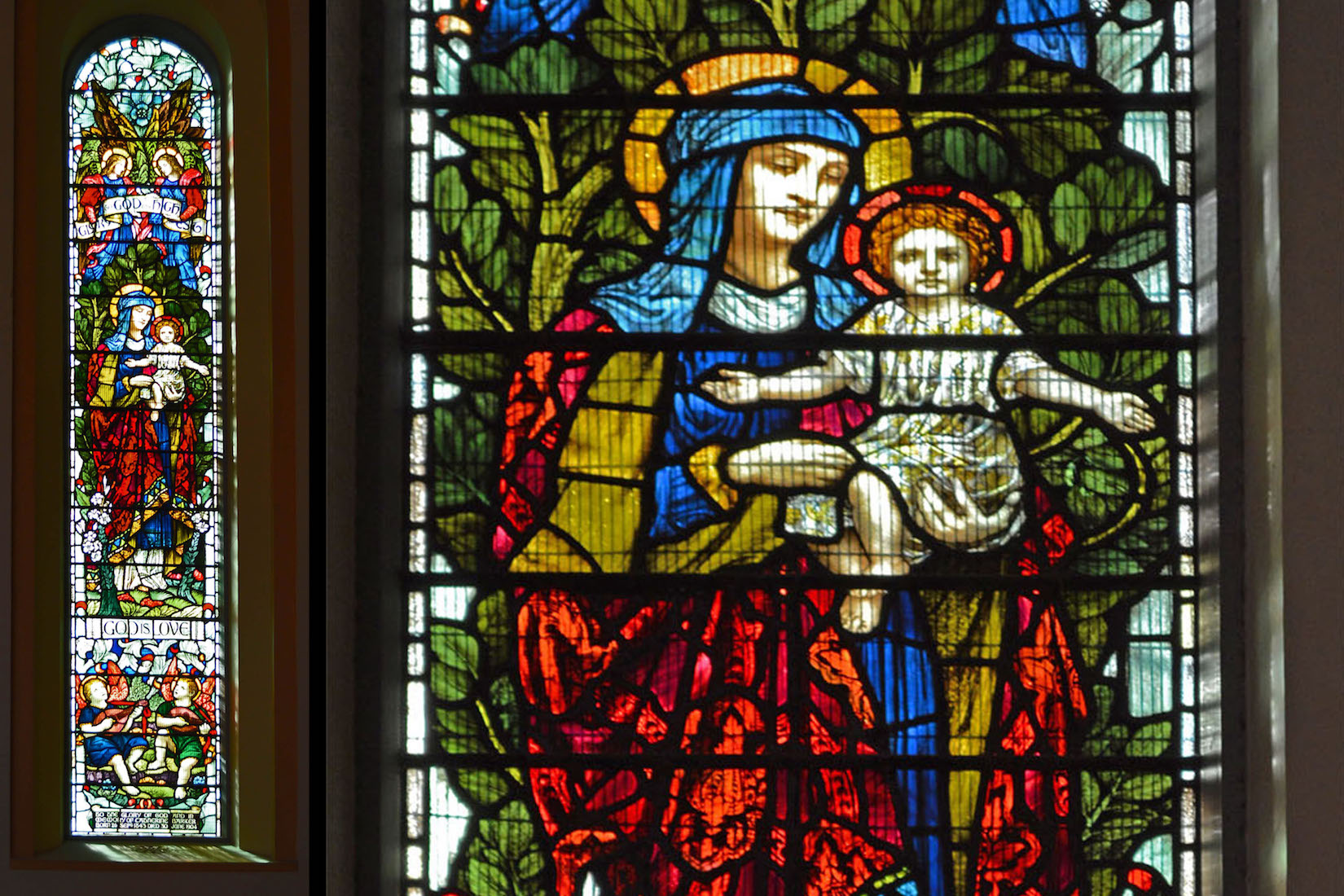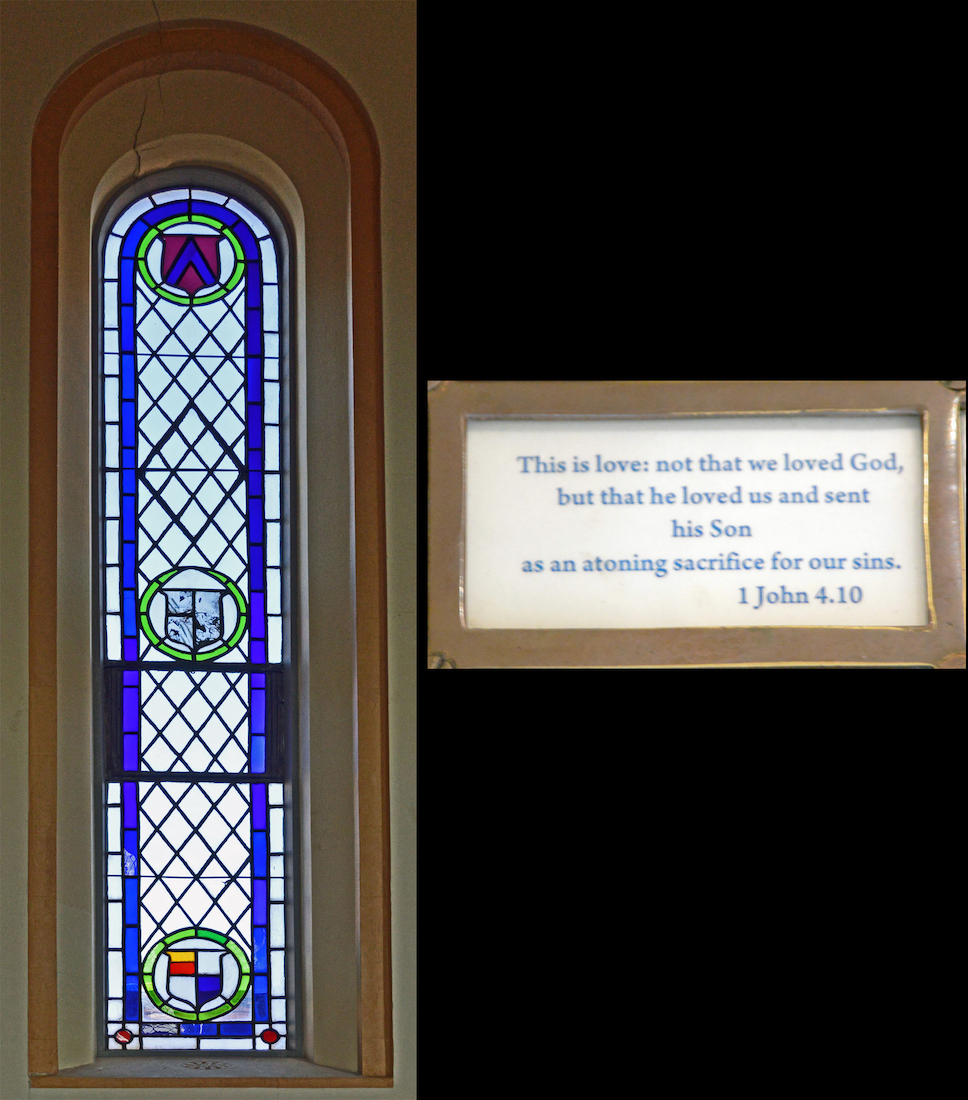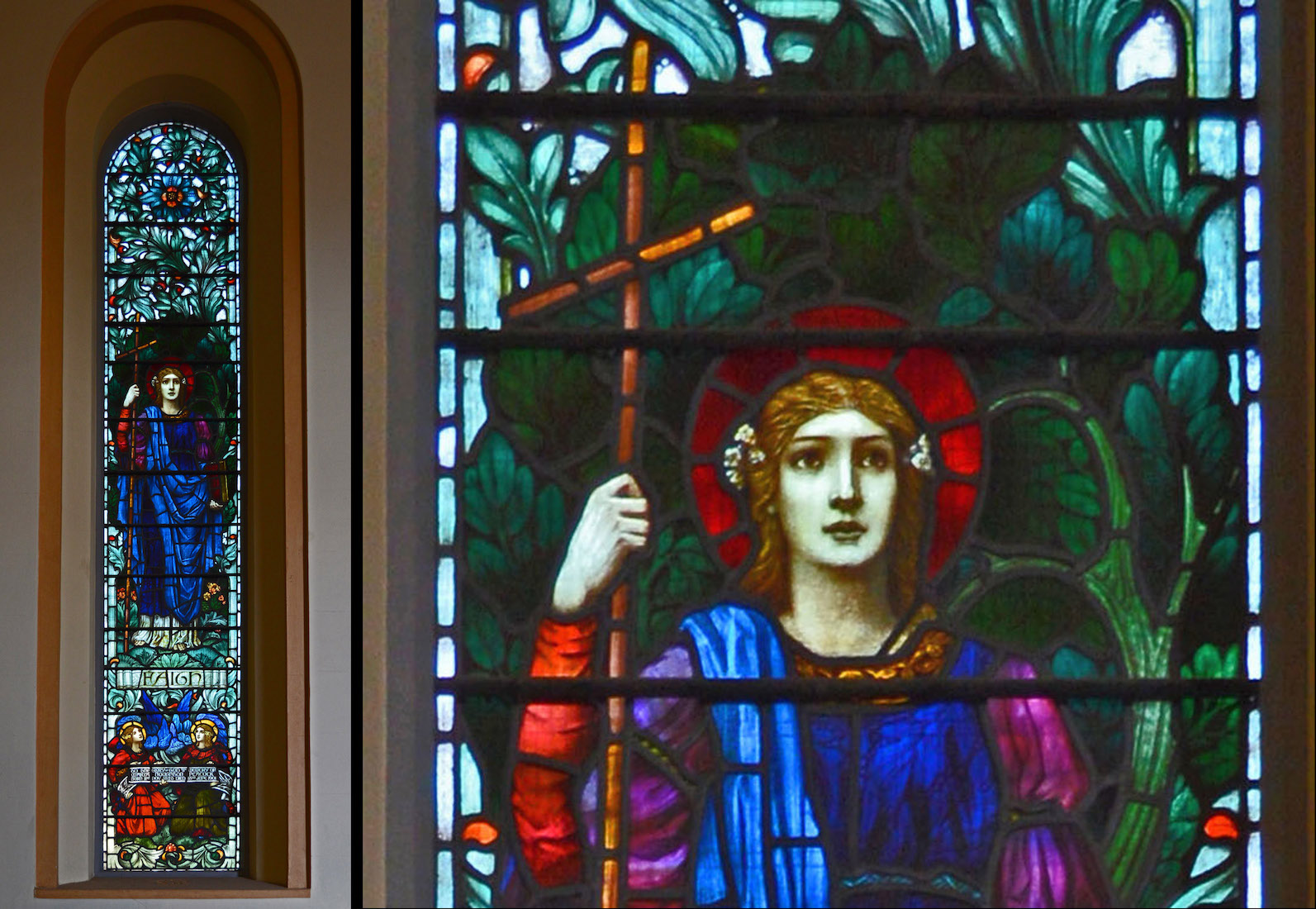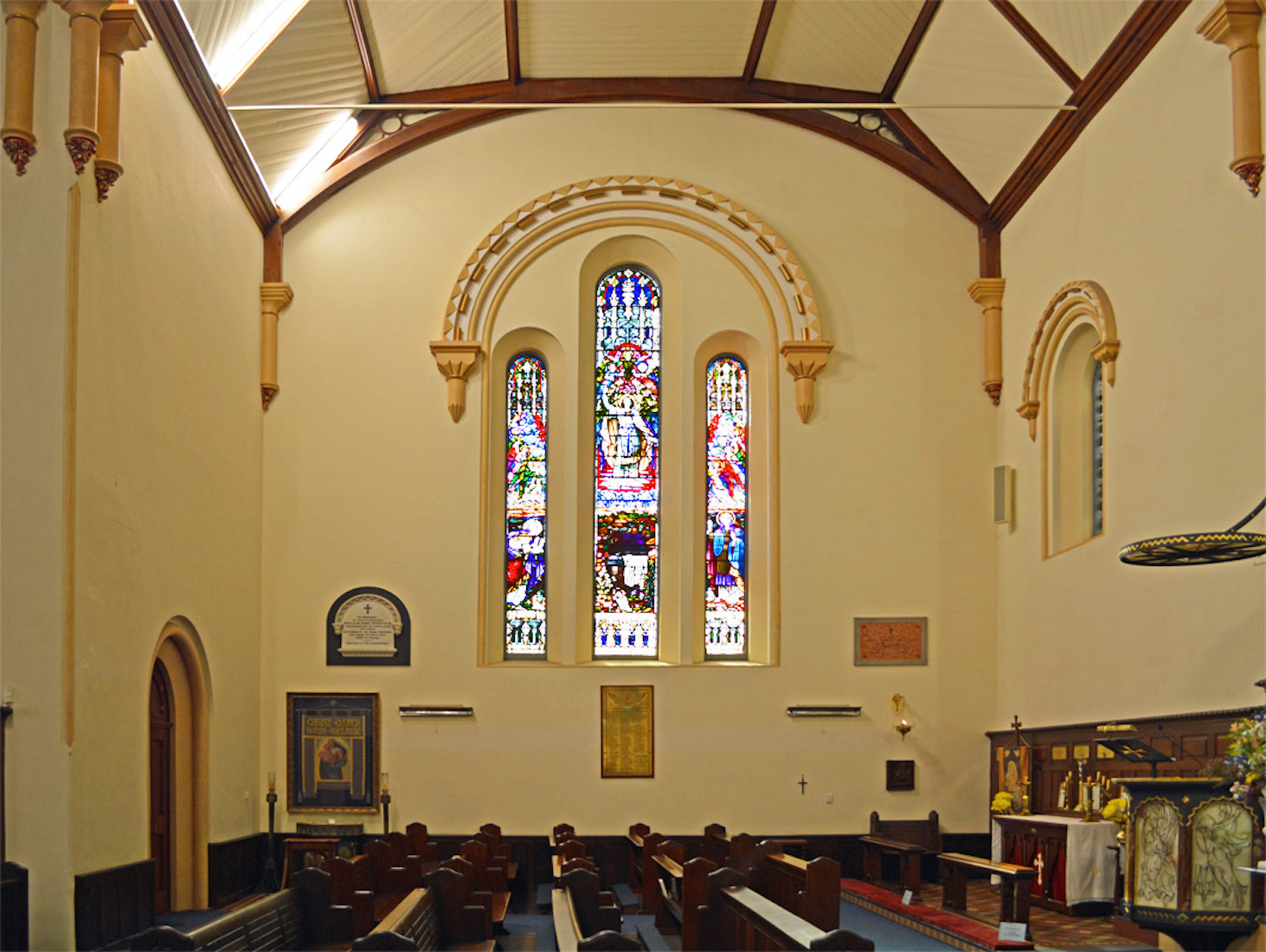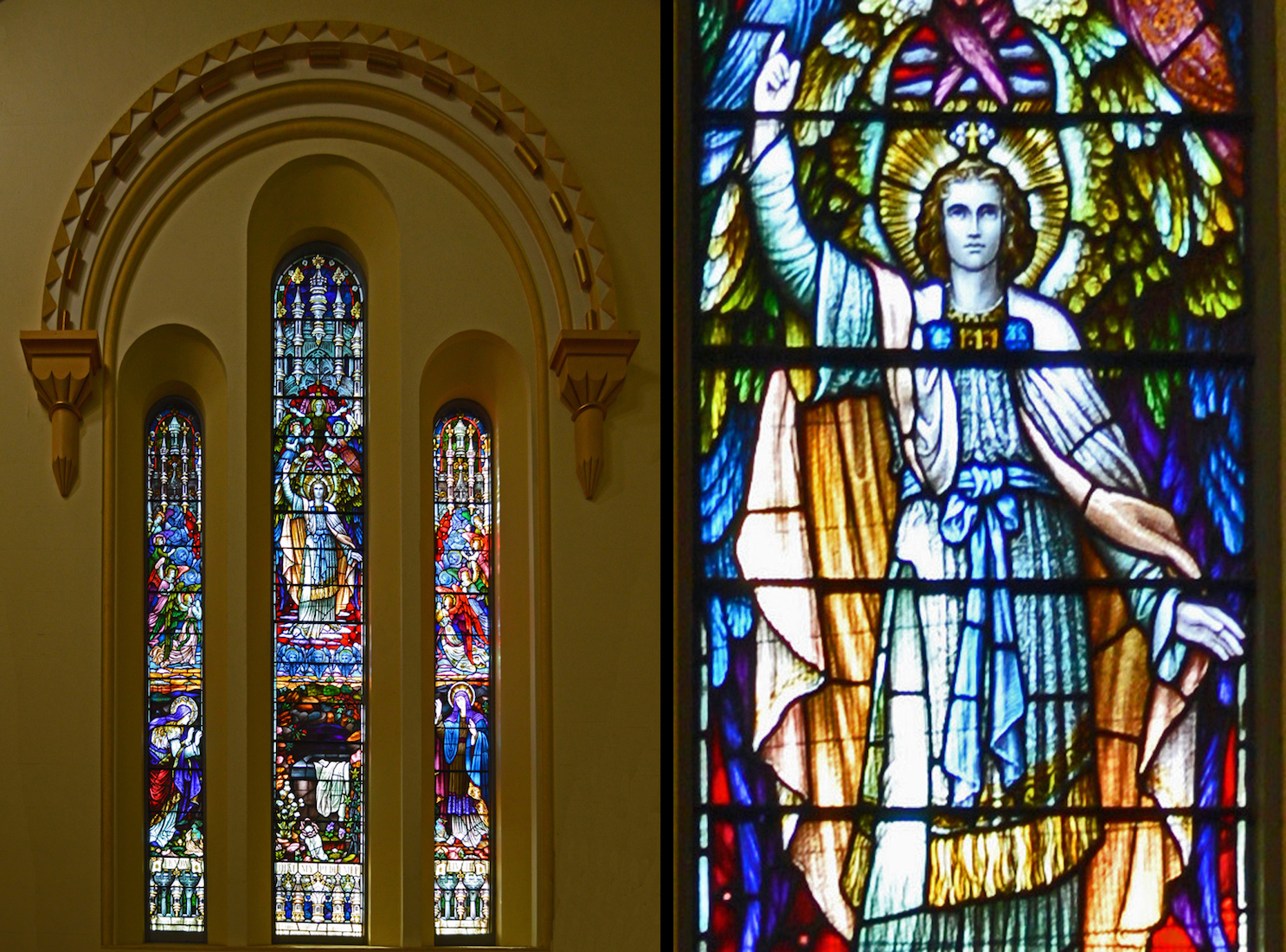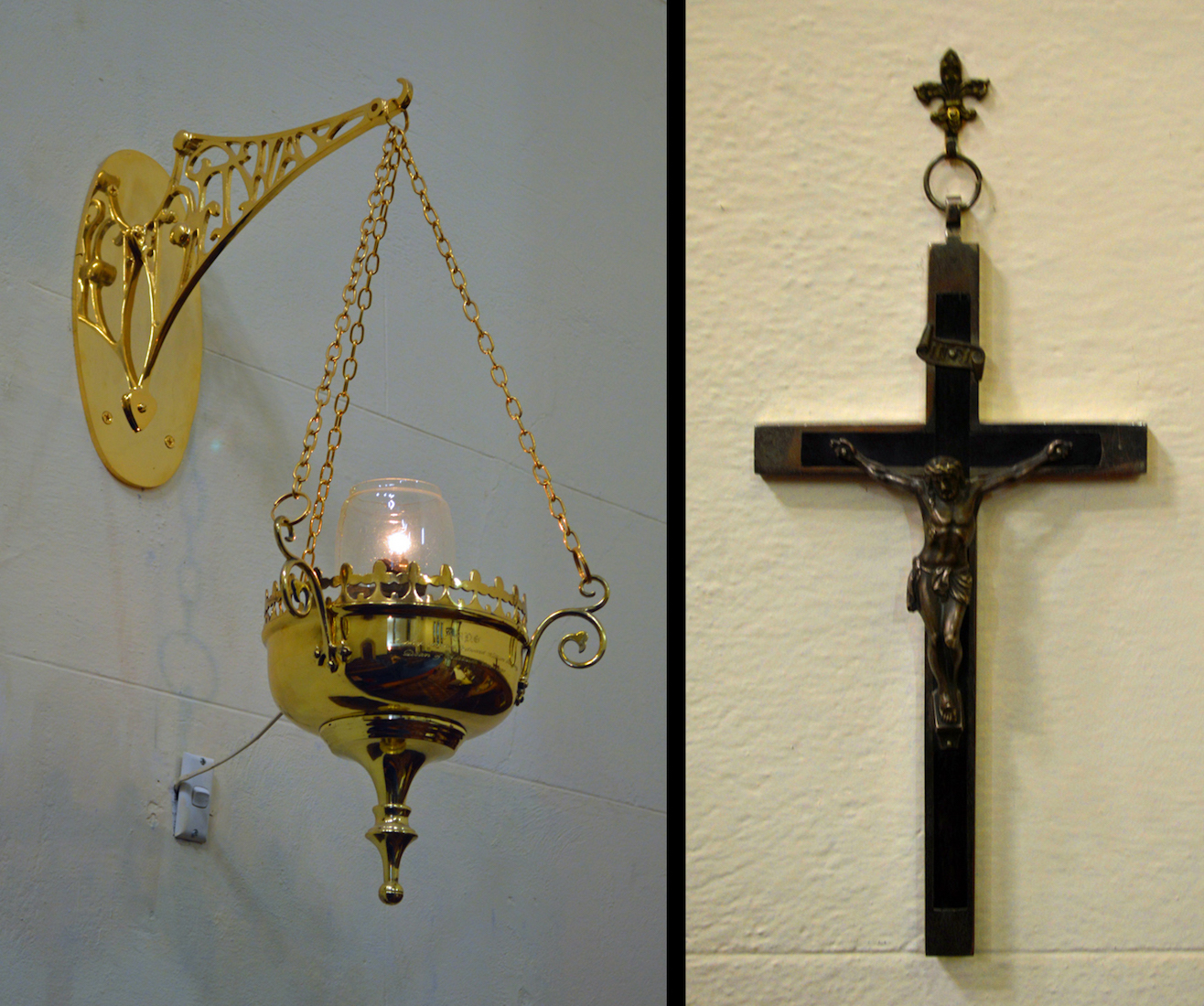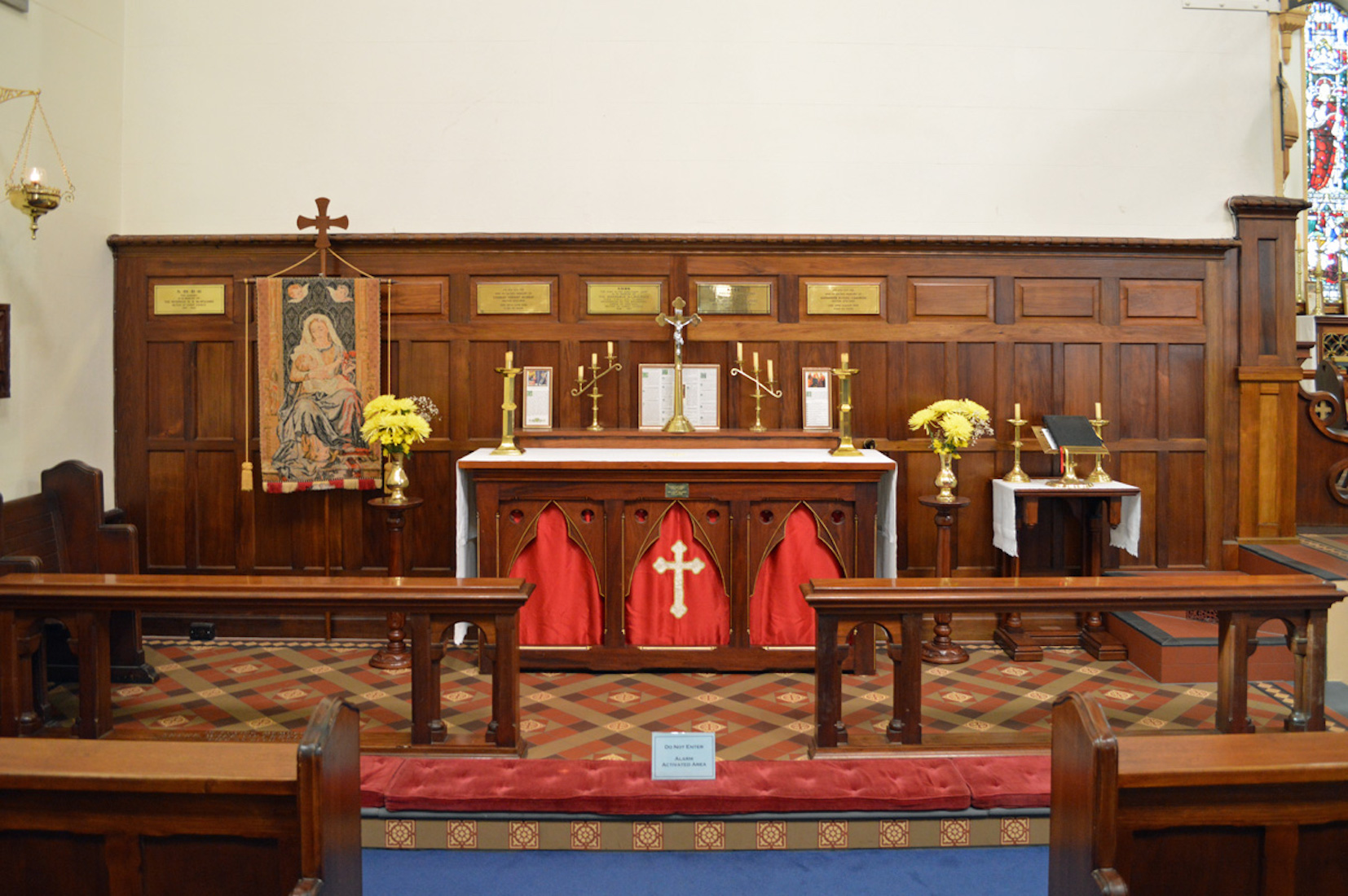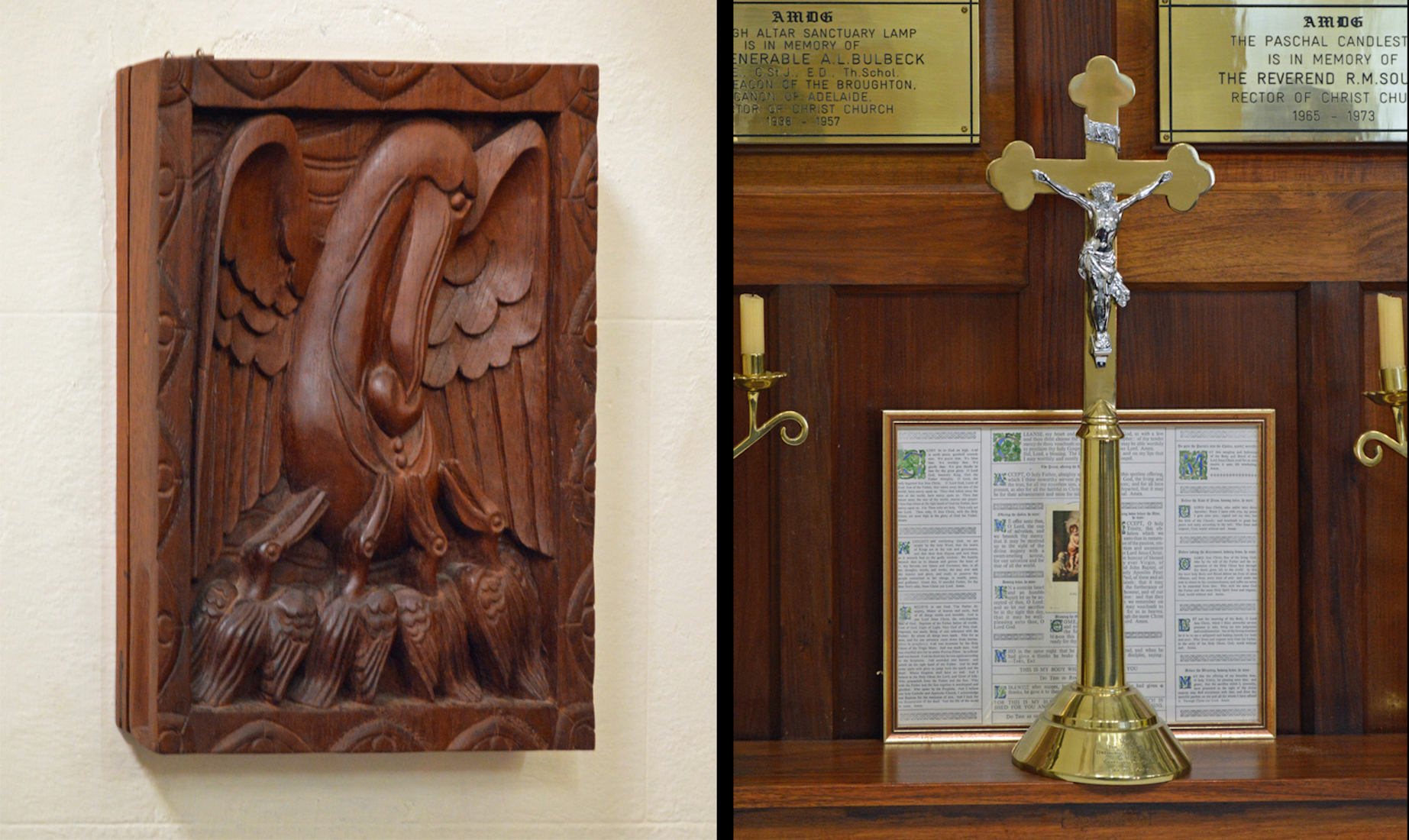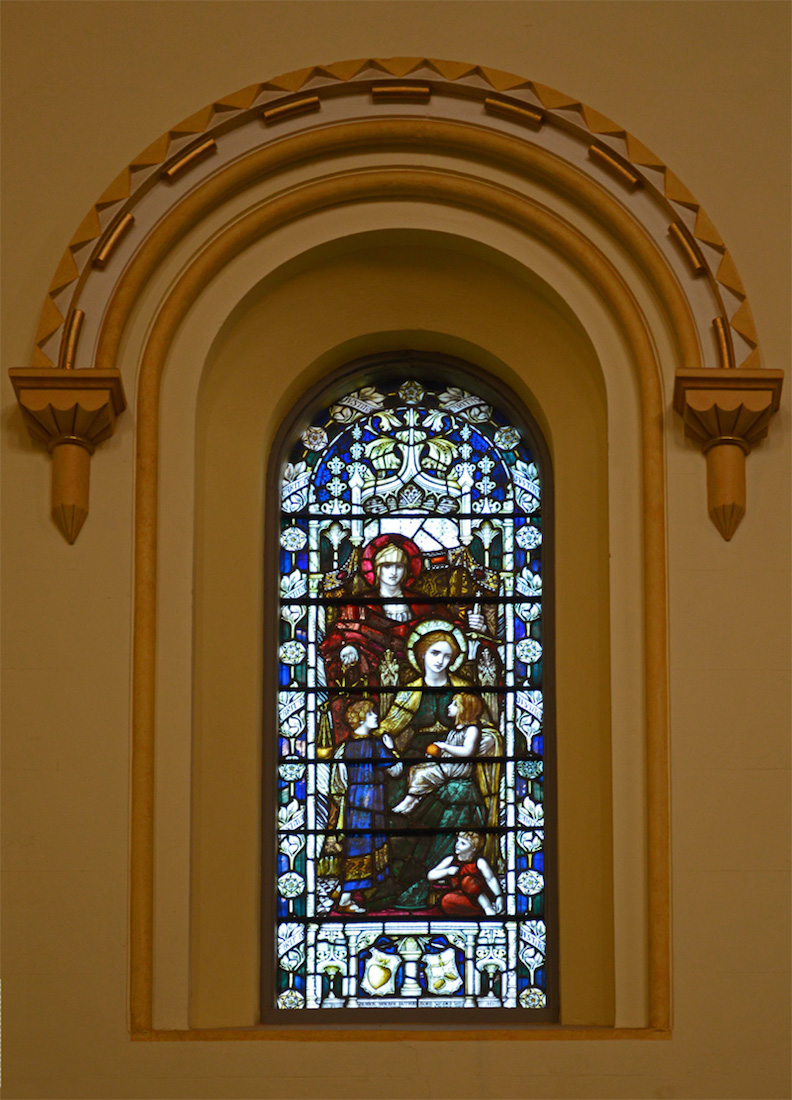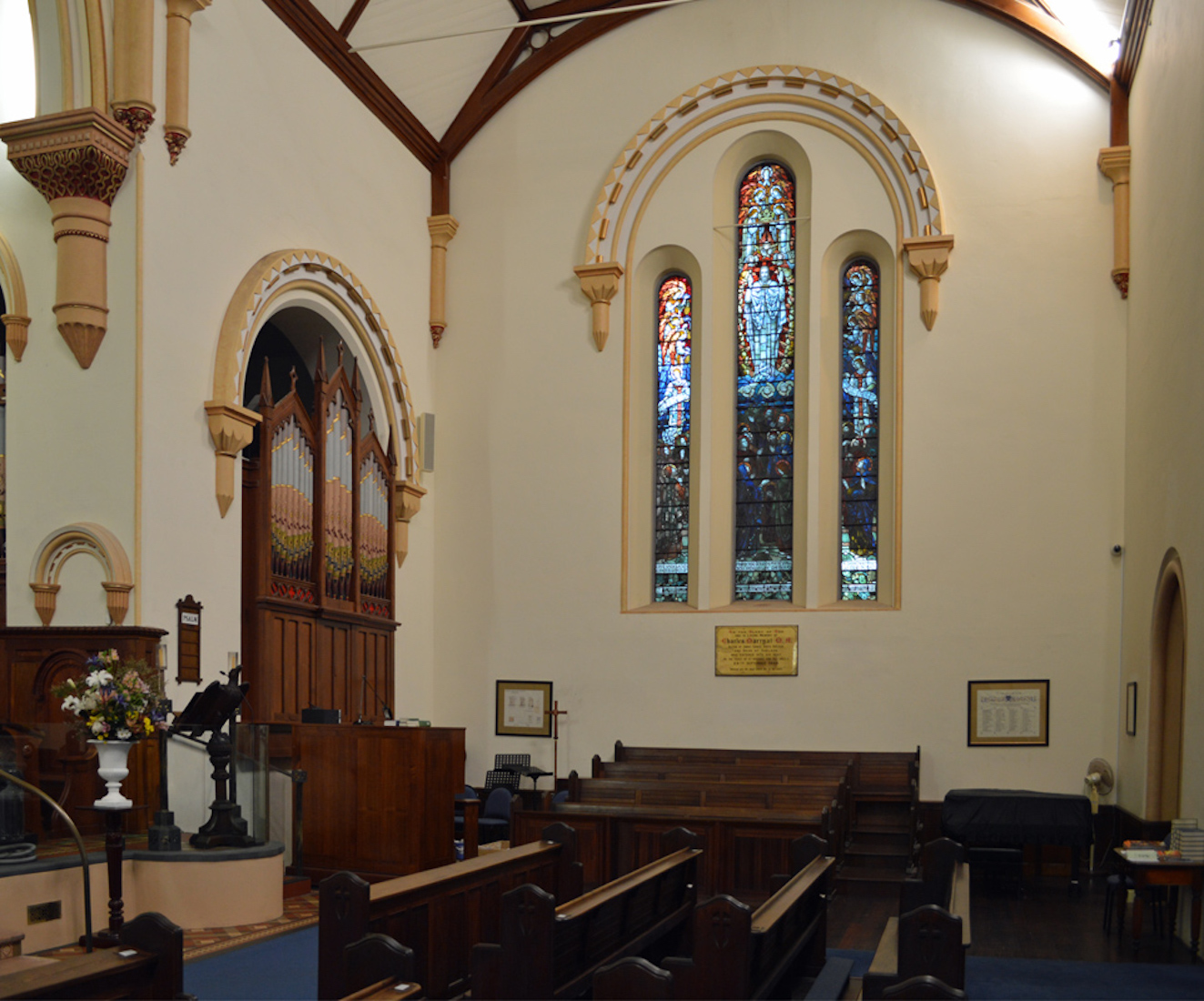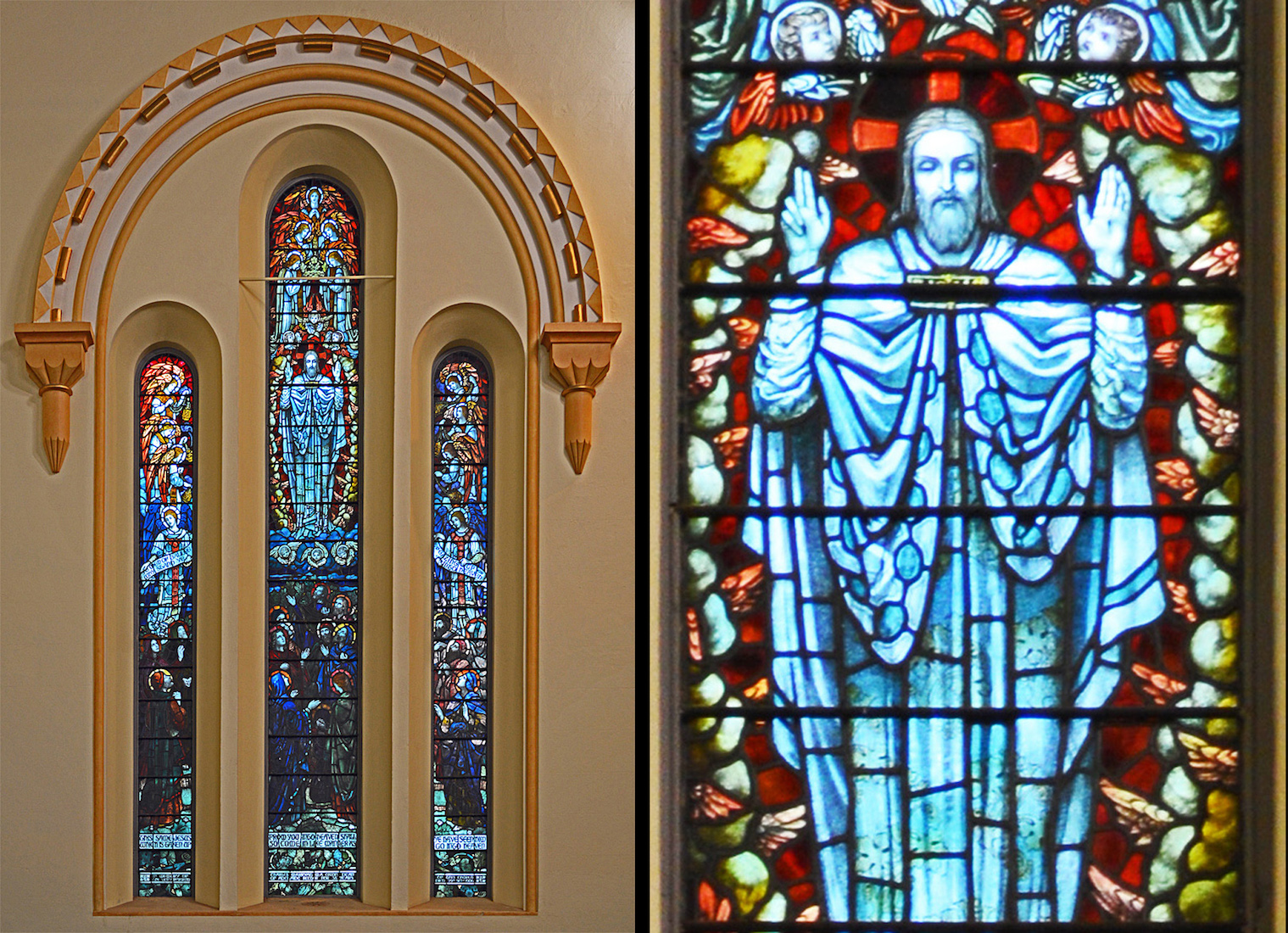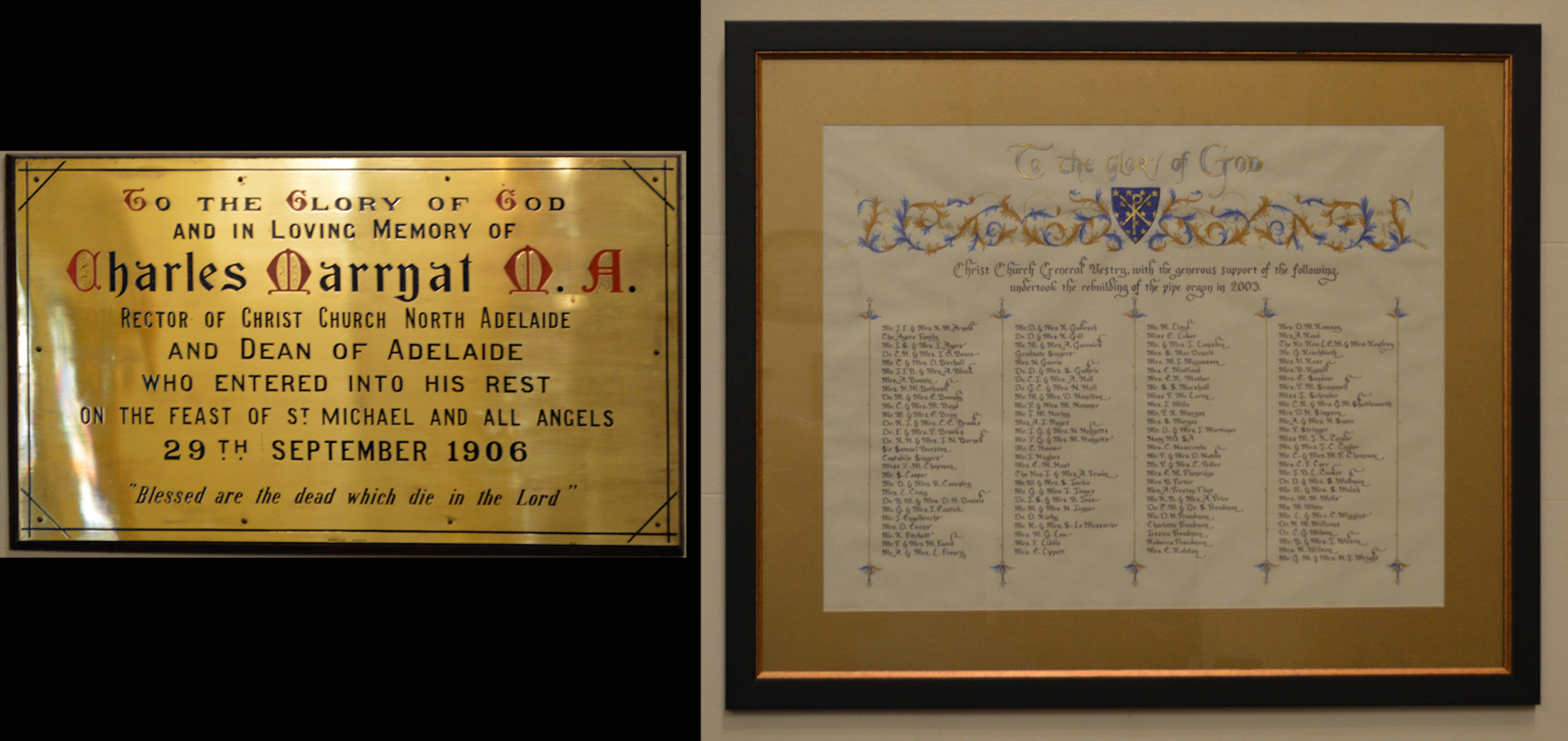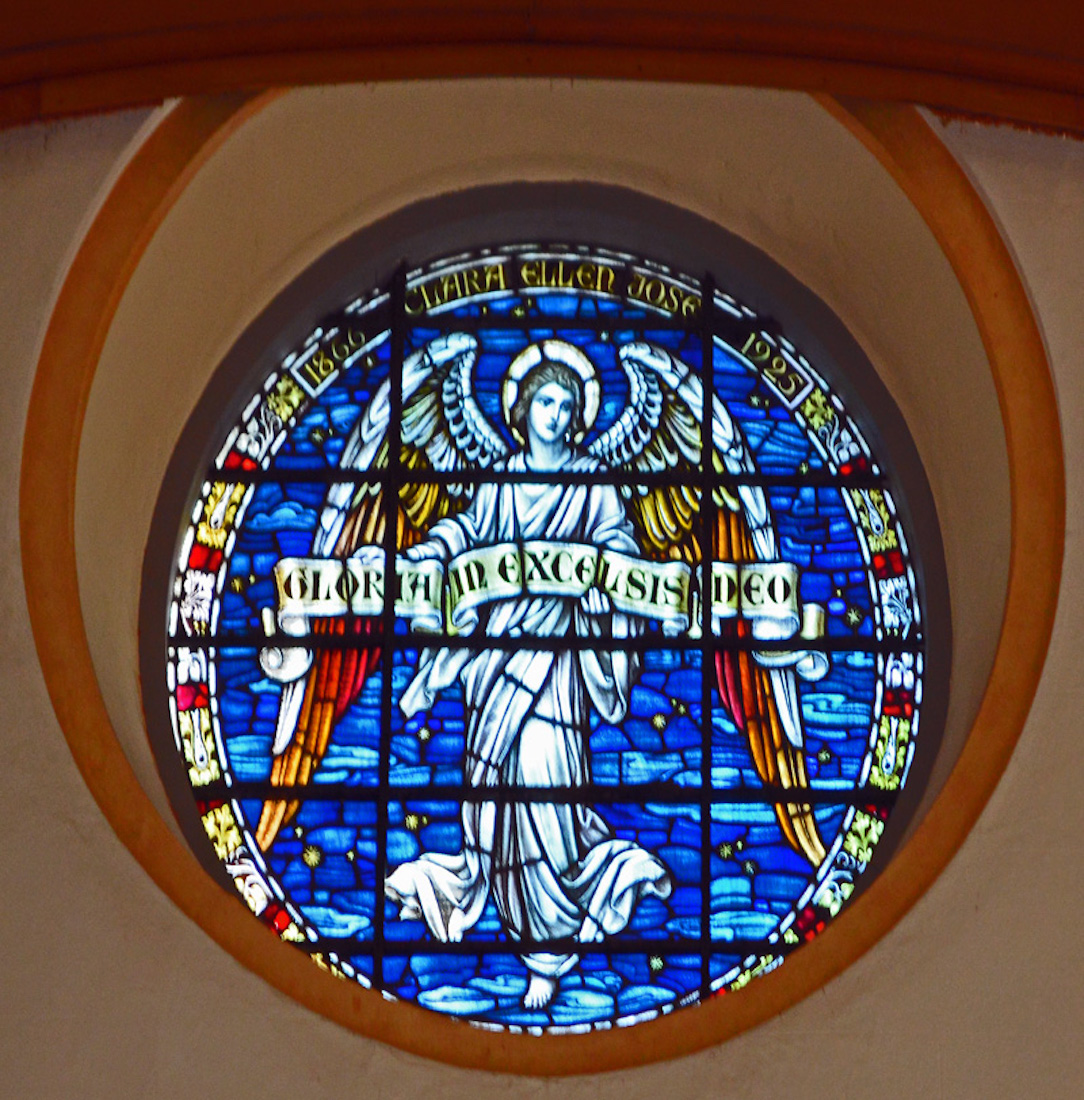
The beautiful round blue window shows an angel carrying a banner with ‘Gloria in excelsis Deo’ written on it. The window was given in memory of Clara Ellen Jose (1866–1925) by her family. This window replaced the former Prince Consort Memorial Window donated by Mrs Brooks in 1862 which had subsequently been blown out. INDEX
22. WEST WINDOW
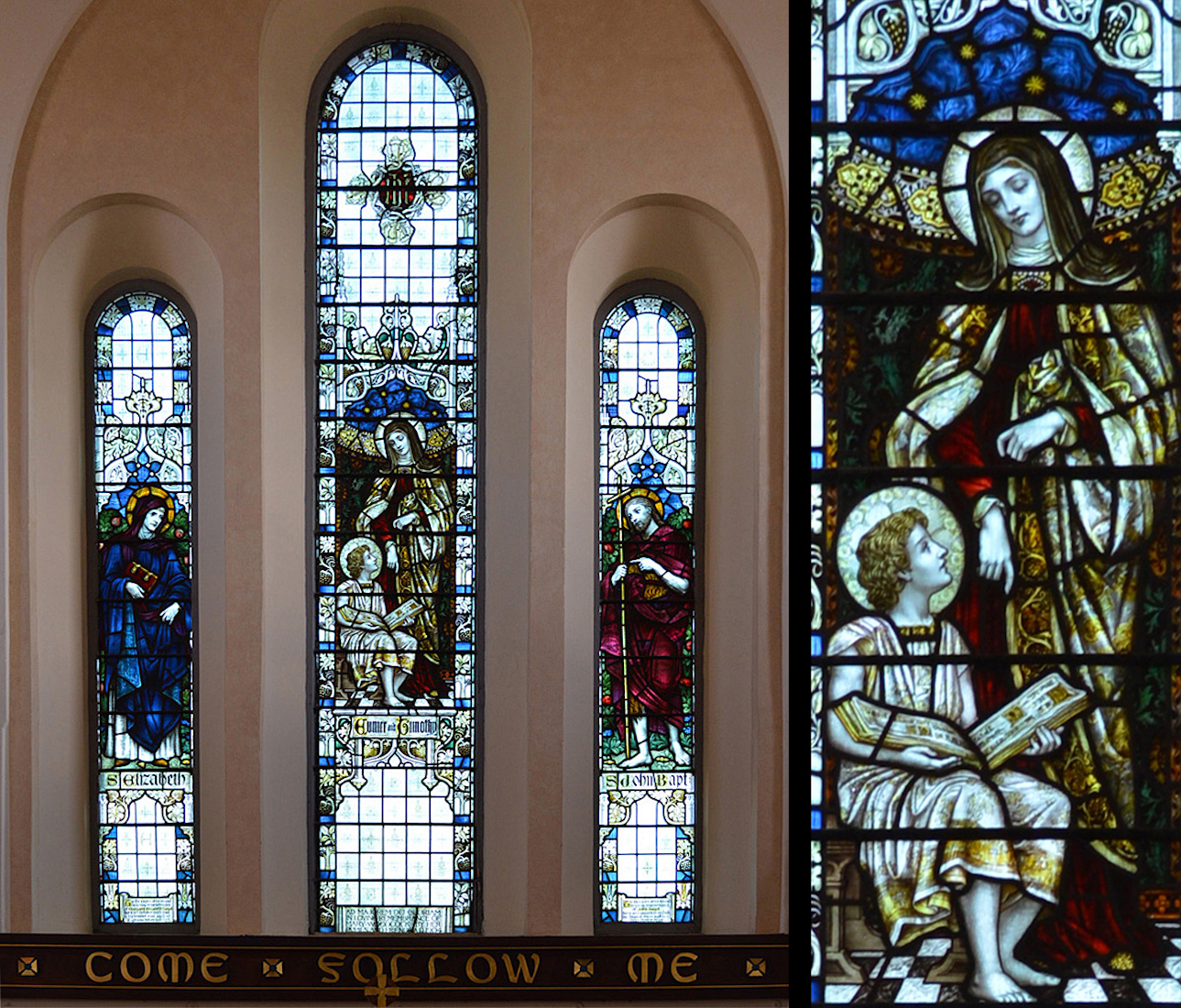
The triple light window in the West wall was installed in 1904. The central panel is dedicated to the memory of Mary Woodcock, and the side panels to Margaret Elizabeth Bagot and Sir John Bagot. The central frame depicts a young Timothy and his mother Eunice. In 2 Tim 1:5, Saint Paul writes to Timothy: ‘I am reminded of your sincere faith, which first lived in your grandmother Lois and in your mother Eunice and, I am persuaded, now lives in you also’. The side panel shows St Elizabeth left and John the Baptist at right.
23. MEMORIAL BOARDS
In 1917, Rolls of Honour for the men who went abroad during the Great War were erected in the church and then unveiled by the Governor, Sir Henry Galway. They fill the whole of the wall space on either side of the West windows, and are of suitably carved blackwood. Temporary panels were inserted on which names were inscribed as the men departed, being replaced at a later time by permanent oak panels. The three panels on the left contain the names of 158 parishioners, and the three on the right those of 131 past members and 47 sons and husbands of parishioners. Only the names differ on the two boards.
24. FONT
The marble baptismal font was erected in 1914. Carved into the marble floor beneath the font is the inscription: ‘In memory of Grace Montgomery Marryat 1833–1910’. In 1926 parishioners donated a carved wooden font cover in memory of Mrs Jose who had died the previous year. The cover bears the inscription: ‘Suffer little children to come unto me’. The first christening within the church was conducted by the Rev’d Woodcock on 30 December 1849, when he baptised his daughter, Harriet Isabella Woodcock, who had been born on the previous 24th of October.
25. NORTH NAVE WINDOW
The stained-glass windows in Christ Church are quite exquisite. This window on the North nave wall shows the Virgin Mary holding the Christ child. Below is the inscription: ‘God is love’. Above, two angels carry a banner with the inscription: ‘Glory to God in the highest’. Below, two cherubs play lutes. The inscription on the base of the window reads: ‘To the glory of God and the memory of Catherine Banker, born 26 Sept 1843, died 30 June 1904. The faint grid effect is due to an exterior protective metal screen.
26. SOUTH NAVE WINDOW, PEW VERSE
At the Western end of the South wall of the nave is this less ornate window. The window displays three light green circles, each containing a shield. The top shield is red with an inverted blue V. The central shield is subdivided into three sections, all mottled grey, and perhaps deteriorated with age. The bottom shield is divided into four quadrants. The top left quadrant bears a yellow stripe and a red stripe; the bottom right quadrant is dark blue, and the remaining two clear. The significance of the shields is unknown to me. At the end of every pew, an inspirational Bible verse has been fixed – a nice touch.
27. SOUTH NAVE WINDOW
Further East along the South nave wall is this attractive window with its brilliant colours. It shows a youthful figure carrying a cross and a book (perhaps a Bible?). The inscription below reads: ‘Faith’. Below this, two cherubs bear a banner with the words: ‘To the glory of God and the memory of Maria Houghton Peacock Born 11th Nov 1828, Died 18th June 1901.
28. NAVE TABLETS
At the East end of the nave walls are two attractive facing blue panels with words in gold. The North panel reads: ‘This is a true saying, and worthy of all men to be received, that Christ Jesus came into the world to save sinners. 1 Tim 1.15. ••• If any man sin, we have an advocate with the Father, Jesus Christ the righteous; and he is the propitiation for our sins. 1 S. John 2.1’ The South panel reads: ‘Come unto me all that travail and are heavy laden, and I will refresh you. S. Math 11.28.’ ••• So God loved the world that he gave his only-begotten Son to the end that all that believe in him should not perish but have everlasting life. S. John 3:16.’ ••• ‘A.M.D.G Hon. Jamie Irwin 16.4.1937–4.11 2005.’
29. NORTH TRANSEPT
Leaving the nave, we turn our attention to the North transept. The facing wall has a large triplet window under its decorative Norman arch, and there is a smaller window at right on the East wall. There are several plaques on the facing wall as well as a sanctuary lamp, and a pelican aumbry. A small altar faces us at left, and at right a larger altar – the focus of the Lady Chapel. The door at the left leads out into the Memorial Garden.
30. NORTH TRANSEPT WINDOW
The beautiful triple light window on the North wall is entitled: ‘The empty tomb'. It was a thanksgiving offering from ‘an old parishioner’. The inscription running across the bottom of the windows is: ‘I know that my Redeemer lives’. At centre is the risen Christ, with the empty tomb below. On either side, angels worship, along with Mary Magdalene at left and Mary the mother of Jesus at right.
31. NORTH TRANSEPT ALTAR, CRUCIFIX
A little prayer centre is set up in the Northwest corner of the transept. On the wall is a framed banner of mother and child, with the title ‘Christ • Church • North • Adelaide. The attractive crucifix at right is located in the nearby Northeast porch.
32. NORTH TRANSEPT MEMORIALS
There are several memorial plaques in the North transept. The large brass plate remembers those who gave their lives in the First World War. Then there is a memorial to George Herbert Jose who lived 1868–1956. He was Canon of St Peter’s Cathedral, Adelaide, Archdeacon of Mount Gambier, South Australia, and Dean of Adelaide. A third plaque commemorates the life of Archdeacon Woodcock who was the first incumbent of Christ Church.
33. NORTH TRANSEPT LAMP, CRUCIFIX
Two other items capture our attention here. The first is an attractive brass sanctuary lamp which looks as though it might have an interesting history. A brass plaque tells us that ‘The high altar sanctuary lamp is in memory of the Venerable A. L. Bulbeck, Archdeacon of The Broughton, Canon of Adelaide, Rector of Christ Church 1930–1937’. The other is a small crucifix which hangs on the corner wall above the pulpit.
34. LADY CHAPEL
In 1934 the Rev’d C. H. Murray transformed the North transept to the Lady Chapel. It is in regular use for weekday services of the Holy Communion. It is said that during the early stages of equipping the Lady Chapel, a keen but not ecclesiastically minded young church officer said to the Rector: ‘I think it is quite a good idea to have a ladies’ chapel, but why not one for the men too in the other transept?’. The chapel altar rails are in memory of Sarah Johns. The candlesticks were given in 1927 in memory of Georgina Bagshaw. The brass vases commemorate G. J. Barrie (1836) and M. G. Berry (1882).
35. NORTH TRANSEPT PELICAN AND CRUCIFIX
At the left of the Lady Chapel altar is an aumbry for the reservation of the sacrament for the communion of the sick, dedicated to the memory of the Rev’d George B. McWilliams. The pelican was said to wound her breast in order to feed her young, and images of the pelican are used to symbolise Christ dying for us to bring us salvation. The altar cross (at right) was a gift in 1962 from the Serbian Orthodox community for ‘extended kindness’. The brass plaques behind the altar are dedicated to previous incumbents of Christ Church.
36. NORTH TRANSEPT EAST WINDOW
Above the Lady Chapel altar is a small stained glass window donated by the Dutton family in 1901 in memory of Mrs Francis Dutton and Miss Caroline Dutton. The window was designed and executed by Mr E. Brooks of Poole Street, North Adelaide. The window appears to show a military figure bearing scales of justice, and a saintly mother with her children. Text down the sides of the window carry the words caritas (love) and justitia (justice).
37. PULPIT
The view at left shows the positioning of the pulpit with the crucifix above. The four rather abstract sketches on the pulpit show in turn (from the left) an angel, a lion, an ox, and an eagle, representing the Four Evangelists. The cross of St John decorates the back of the lectern stand.
38. SOUTH TRANSEPT
Before proceeding to the chancel and the sanctuary, we move across to the South transept. A grand window dominates the South wall, which also carries several plaques. A stand of colourful organ pipes and a fancy wooden eagle lectern are at left, and the entry door from the Southeast porch is it right. In 1996 most of the pews were removed from this area to create a space which could be used by choirs and musicians. To make this possible, a new organ console was installed in 1997/8 and new chairs were purchased to furnish the area.
39. SOUTH TRANSEPT WINDOW
The three light window depicting the Ascension of our Lord was placed in the South wall in memory of Dean Marryat by his family. The window is perhaps the best example to be found in Adelaide of the work of Melbourne stained-glass artist William Montgomery. The figure of Christ dominates the central window, while at the bottom of the three windows the disciples and others are pictured gazing upwards. The angels in the side windows hold banners with the inscription: ‘Ye men of Galilee, why stand ye gazing up into heaven?’
40. SOUTH TRANSEPT PLATE AND CERTIFICATE
Directly below the window is this brass plate commemorating the life of Dean Charles Marryat who died in 1906. The colourful parchment at right lists the individuals who contributed to the rebuilding of the Christ Church pipe organ in 2003.


